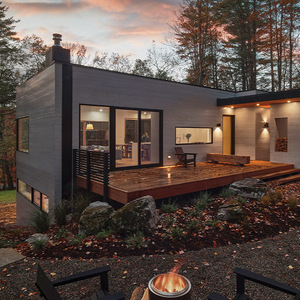For lighting the closet, and powering the light, we like to dispense with a wallmount switch outside, and instead put a jamb switch in, the kind which requires a tedious little mortise cut in the hinge jamb.
Here’s one from Leviton we’ve used.
Have you done it with a prox switch instead? Like this, or something similar? This is from Leviton, also.
If so, how do your costs compare, this to a jamb-mount? Furthermore, where do you put it so when the closet gets all jammed up with stuff, the switch can still “see” the door move so as to make contact?
Edited 3/26/2007 9:38 pm ET by Gene_Davis




















Replies
Gene,
I don't see how the motion sensor will work very well unless we are talkking at minimum a large or walk-in closet.
The top one is low voltage to a relay isn't it?
We di d a few last year and that is the best I can recollect. For some reason I want to say we used something that went in the head jamb and did not need to br mortised.
Eric
[email protected]
The jamb switch shown at top in my OP is pretty big, Eric, and it is for line voltage.
Gene, that looks like passive IR to me. IF so (maybe it says in the specs) it doesn't need a real clean line of sight as it picks up a sudden change in IR (temperature) radiation.
PaulB
http://www.finecontracting.com
man i wanted to use some of the first type.... the ones i looked at were not low voltage... and even with finding a deal on the switches... hell even if they were free... the time it takes to install em.... makes it an easy $200 switch... which ain't bad if you have one... but when you have 15 it's a bite i wasn't going for this time...
i did see on the net somewhere where there is a rf switch device you screw into the bulb socket and a contact you place on the door... that will switch the light off & on with the operation of the door... for less than $20 a pop...
p
The jamb switch requires the door to fully close for the light to go out. OK if you anal about keeping your closet doors closed all the time, but kids do not always keep doors closed! Also, a large walk in closet may be more like another room, so the door stays open.
Motion detectors require motion to stay on. Probably OK for a small closet you do not walk in, but one could stay in a walk in closet long enough for the light to go out, if the switch was outside looking for door movement.
The mortise switch is full voltage. It is large so that it can hold the wires in its own junction box.
Put the wall mount switch inside the closet and you don't have to stare at it! The motion sensing switch is even bigger and uglier than the single pole switch.
Go with what you like. We do not all live the same lifestyle.
Frank DuVal
You can never make something foolproof because fools are so ingenious.
Have you used an of the "occupancy" switches?Are they just motion sensing or do they also stay one if you are still in range?http://www.sensorswitch.com/
http://www.wattstopper.com/
.
.
A-holes. Hey every group has to have one. And I have been elected to be the one. I should make that my tagline.
The occupancy sensors DO NOT stay on if your aren't moving [very much]. I hate them. They are very dangerous if you are working on a live panel and are moving very slowly and carefully. They do not sense movement and suddenly the lightss go out.
The Levinton ones fit in a norbal single gang box. They cheat and use the ground wire for return circuitry for their electronics.
~Peter, former applicant for the position of Copy Editor for FHB.
Wattstoppers are what we use in our restrooms and conference rooms. The WS-200-W model uses IR for sensing and has a good range of adjustment for both area covered and time off delay. It is line voltage 120 or 277 and fits in a single gange boxx ok. We also use the model that has a remote sensor that uses IR and some type of ultra sonic detection. They have a transformer and relay as well as a override switch(off, I think). We have had some problems with them in conference rooms, mostly faulty relays or tweaking the adjustments. In some cases we just take the darn things out and go back to a single pole switch with a cover plate the says "please turn out the lights when you leave." Frankly, they are all a PITA to mess with.
Dave
Why worry about the power. I though that you have a special deal and got it wholesale <VBG>.So none of the "occupancy" sensors are occupancy sensors, but rather they are all motion sensors.I have one in a perfect location. I have a walkout basement and just inside the doors I keep my water ski equipment.Most of the time that I go intheir to get it the sun is very bright and I can't see anything so I have to turn on the light. The switch happened to be at exactly the right place for a motion sensor.But the lighting in rest of the area is on a separate switch so no problem timing out.BTW Chamblerlain (garage door openers) makes a neat wall control panel that includes a motion sensor that turns on the opener light. Really handy for things like take the trash out.I have only seen them on the pro models (Liftmaster), but they also work on the Sears and Chamberlain Security+ models. Those are the ones with separate light and lock controls in addition to the door control..
.
A-holes. Hey every group has to have one. And I have been elected to be the one. I should make that my tagline.
We just put some in on a job.
You have to walk right in, or wave your arms around to get the light to come on.
this isn't a answer ,just opinion. i don't think there is any other 20.00 item you can put in a house for more wow factor. people are just fasinated with a light that goes off when they shut the door. i find it funny to watch.more people comment on the pantry door light than on the granite countertops by far.
they do take about 30 mins to install ,but i honestly think it can make your house stand out from evrybody else's. larry
hand me the chainsaw, i need to trim the casing just a hair.
Gene,
I had the electrician put a motion activated switch in a master closet.
the size of the closet is 9x7' if i recall. It has french doors that swing out and nobody had a definit feel for where the switch should go.
We (Electrician) mounted the sensor on the ceiling inside the closet about a foot away from and centered from the door.
The instant the door opens it comes on, they have told me there has been no problems with it prematurely going off.
They love it.
I will definetly do it again.
The cost was nothing more than what the sensor cost. 20.00?
Fits in a single gange box no problemo..
Edited 3/27/2007 12:29 am ET by PASSIN
the kind which requires a tedious little mortise cut in the hinge jamb.
I love those jamb switches, but only if we're there to drill the hole for the wire and mortice the stud before the wire or door are installed. Probably cuts my time in half if the coordination works out right.
This is also a good excuse to make a router template since that will really speed things up. Even without a template the door stop is probably best removed so the router can clean things up.
I also ask the electrican to not staple the wire too close to the hole so it can be carefully pushed back out of the way while the door is being morticed and fished out with needle nosed pliers when the cuttin's done.
All told they take about $20 of my time if things work out right, which combined with the switch is still in the ball park of reasonability.
Good switching
Beer was created so carpenters wouldn't rule the world.
I've got the lower one installed in the kids' secret room (pretty small); my thought in your app is to put it up high enough that it can't be blocked - maybe even in the ceiling, with the long side toward the door, so the viewing arc includes it.
It is as easy to install as a switch; if it's in the ceiling, you could add another switch (in parallel) by the door.
Forrest
While not ideal, what seemed to get the fewest call-backs to adjust sensitivity, and "on" duration, was to skip motion and use magnetic door sensors (the alarm kind).
The "buried" kind are not bad, if you are in the jambs & casing anyway; but, the trim-n-door pairs seemed easier to cope with ajar, but almost closed = "off" conditions (as you can cheat the door half "close" to the trim-mounted open sensor.
I've seen some dinky closets rigged with the screw-in-base motion sensors--but the delay & sensitivity were almost always under-adjustable (but, it's a slick answer for a 3x2 closet).
Ceiling is the best place, if you go with a motion switch (double check that it works in the horizontal--as it's a pain to learn after the fact). As flush as possible, too, so noting gets hung over or on it.
The comment on "wow" factor is apt, though. Only step up is to ditch that single ceiling bulb for 3-4 LV aimable or track fixtures that actually light up the closet contents (really gets an "Woah, cool . . . ")
I just put a wall toggle switch inside the closets for the ceiling lights. My wife got a lot of WOW out of that.
We must just be simple folks ....
I've used both.
I really liked the motion sensor concept, but I kept the sparky busy swapping out different units until we finally got would function properly. Used to pizz off the wife when it turned on in the middle of the nite with the doors closed and us in bed - out of range. But once we got a decent unit in it, it worked fine. Can't go cheep.
Although install costs were a bit higher, the jamb switch has been foolproof.
The 110V jamb switches are usually too wide and the edge can be seen with the door closed, never mind what a PITA to install. We got away from that by using a "rollerball" alarm contact (12) which is used with a RIB-relay (brand name, relay in a box) which we mount on top of a flouresent strip light mounted above the door header, works like a charm, dont even notice it, but it aint cheap.
We got away from that by using a "rollerball" alarm contact (12) which is used with a RIB-relay (brand name, relay in a box) which we mount on top of a flouresent strip light mounted above the door header, works like a charm, dont even notice it, but it aint cheap.
Bingo Gene, this is exactly what I have used. Easy install.
Incandescents are a no-no in most closets here.[email protected]